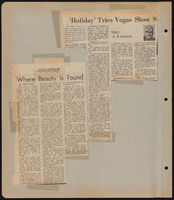Search the Special Collections and Archives Portal
Search Results
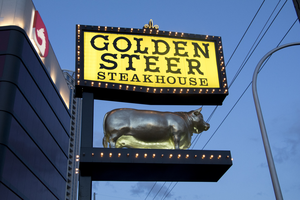
Photographs of Golden Steer Steakhouse sign, Las Vegas (Nev.), March 3, 2017
Date
Archival Collection
Description
Site name: Golden Steer Steak House (Las Vegas, Nev.)
Site address: 308 W Sahara Ave
Sign owner: Dr. Michael J. Signorelli has owned it since 2001 after purchasing it from the original owners
Sign details: Opened 1958, and started expanding in the 1970's by buying out neighboring shops. They redesigned their interior in the 90's but still kept it true to the original design. The Rat Pack was known to frequent this steakhouse and even have a dedicated booth to them. Tony Spilotro, Elvis Presley and Nat "King" Cole were a few of the many famous customers. This is the Oldest Steakhouse in Las Vegas, and still maintains their original old Vegas dining style.
Sign condition: 4-The sign looks as though it has aged, but it has done so gracefully
Sign form: Pylon with sculptural element and entrance sign on building
Sign-specific description: The Pylon sign has the main logo stating "Golden Steer Steakhouse" on a yellow sign with a black border. The black border has yellow/gold incandescent light bulbs with a small gold Fleur-de-Lis on the top. Under the main logo there is a shelf/stage holding a golden sculptural steer. The sign above the entrance is a wrap around yellow sign similar to their pylon sign with their logo and an image of a steer in between the words Golden and Steer. They also advertise Prime Rib and Seafood on the wrap around sign.
Sign - type of display: Incandescents surrounding all of their "reader board" type signs, no neon tubing
Sign - media: Plastic and steel
Sign - non-neon treatments: Reader board type plastic for for all the wording
Sign animation: Chasing:
Notes: ncandescent light bulbs
Sign environment: On West Sahara a few blocks West of Las Vegas Blvd.
Sign manufacturer: Wright Signs
Sign designer: Origninal Steer from the 60's and John Burke said the record of the designer was lost
Sign - date of installation: Pylon sign-1960's but refabricated around 2015 to its original condition, but still original steer. Sign above entrance still from the 1970's.
Sign - date of redesign/move: Pylon sign-1960's but restored around 2015 to its original condition, but still original steer. Sign above entrance still from the 1970's.
Sign - thematic influences: Sign shows old west type font. The Golden sculptural steer helps show it is a steakhouse but one that is top of the line since their sign is golden.
Sign - artistic significance: Opened in 1958, still had the prominent old west/ ranch theme that was popular in Vegas in the 1950's. Though the interior was classy their signage shows the old west cowboy style.
Survey - research locations: Assessor's page, Golden Steer website https://www.goldensteerlasvegas.com/our_history.html , Telephone conversation with John Burke the General Manager of the restaurant
Survey - research notes: John Burke has a lot of great info on their signage as well as their property. Also the Golden Steer website had a great history of the property.
Survey - other remarks: Some of the older Golden Steer signage is in the Neon Museum.
Surveyor: Emily Fellmer
Survey - date completed: 2017-07-28
Sign keywords: Sculptural; Plastic; Steel; Incandescent; Chasing; Reader board; Building-front design; Pole sign
Mixed Content
Stardust Hotel and Resort promotional video; Meadows Mall holiday display promotion; Monte Hale stars in Frontier Hotel promotional video
Date
Archival Collection
Description
Promotional video for Stardust Hotel and Resort showing amenities including the pool, dining options, interior of hotel rooms, sports and gaming, and various entertainment programs available; voiceover describing everything while short clips show onscreen, ends with a phone number to call; same ad runs twice. Second segment is promotional video for the Meadows Mall Christmas display with the slogan of "Meadows Mall means Christmas"; second segment appears to be b-roll for the same Christmas village promotional video with music playing over the same shots of the holiday display. Third segment is Monte Hale appearing in a promotional video for the Frontier Hotel; he walks through the hotel, dining, entertainment options while in Western-style clothing and at times, riding a horse. Same Meadows Mall clip runs again. Original media U-matic S, color, aspect ratio 4 x 3, frame size 720 x 486. From the Production Company Audiovisual Collection (MS-00930) -- Digitized audiovisual material file.
Moving Image
Donna Silva Lighting Design Plans
Identifier
Abstract
The Donna Silva Lighting Design Plans (1986-1996) contain blueprints and schedule binders for a number of projects Silva worked on in Las Vegas, Nevada including the New York-New York Hotel & Casino, The Orleans Hotel & Casino, Golden Nugget, and the MGM Grand Hotel. Also included are lighting plans for the Foxwoods Resort Casino (operated by the Mashantucket Pequot Tribal Nation) in Connecticut, Caesars Atlantic City, and Players Island (now CasaBlanca Resort) in Mesquite, Nevada.
Archival Collection
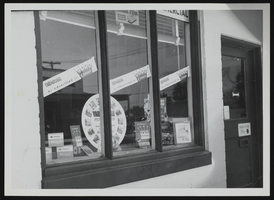
Photograph of Woodruff's Basic Photo Shop image 004 of 004: photographic print
Description
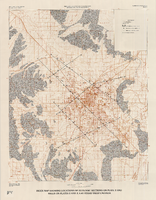
Index map showing locations of geologic sections on plate 2 and wells on plates 2 and 3, Las Vegas Valley, Nevada, 1981 (Water-supply paper 2320-A)
Date
Description
Image

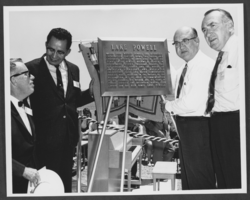
Photograph of Powell Commemorative Ceremony, Lake Powell, June 19, 1969
Date
Archival Collection
Description
Image

Transcript of interview with Patricia Mulroy by Stefani Evans and Claytee D. White, January 03, 2017
Date
Archival Collection
Description
Patricia Mulroy served Las Vegas as the general manager of the Las Vegas Valley Water District from 1989 to 2014. She served the state of Nevada as the general manager of the Southern Nevada Water Authority from 1993 to 2014. Patricia helped to build the Authority, and saw the state through the devastating drought of the Colorado River. Patricia was born in Frankfurt, Germany on February 24, 1953. As a young girl, she lived in several different countries, but always felt that the United States was her home. Her experiences abroad fed her to develop a fascination with government work and state service. She arrived in Nevada in 1974 to attend UNLV. In 1989, Patricia became the general manager of the Las Vegas Valley Water District. She entered the field at a tumultuous time, facing the drought of the Colorado River and tension within the districts. She pioneered the Water Authority, which revolutionized Southern Nevada’s water rights system and allowed the districts to deal with the issue cooperatively. She worked with other Southwestern states and Mexico to support Las Vegas and Nevada through the drought. Patricia retired in 2014, but has chosen to remain active in politics and business. She is currently working with the World Bank in China on the World Economic Forum. She is also a nonresident Senior Fellow at the Brookings Institute, a faculty advisor for the Desert Research Institute, and a board member of the Wynn Board of Directors.
Text

